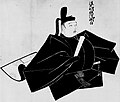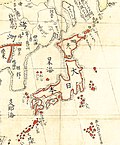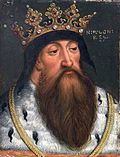Nijō Yoshimoto (二条 良基, 1320 – July 16, 1388), son of regent Nijō Michihira, was a Japanese kugyō (court noble), waka poet, and renga master of the early...
5 KB (493 words) - 16:36, 4 February 2023
period Japan Nijō Yoshimoto, 14th-century Japanese poet Banana Yoshimoto, pen name of Japanese writer Mahoko Yoshimoto Hiroki Yoshimoto, Japanese race...
855 bytes (108 words) - 20:03, 13 June 2023
Fujiwara were divided into Five regent houses (五摂家, Go-sekke): the Konoe, Kujō, Nijō, Ichijo, and Takatsukasa families. From then on, these five families served...
34 KB (1,228 words) - 07:15, 16 September 2024
between 1368 and 1376. The author is not known but is believed to be Nijō Yoshimoto. It is the last of four works of mirror series and follows most recent...
1 KB (149 words) - 17:50, 24 September 2024
Nijō Moroyoshi (二条 師良, 1345–1382), son of regent Nijō Yoshimoto, was a Japanese kugyō (court noble) of the early Muromachi period (1336–1573). He held...
938 bytes (71 words) - 08:45, 4 February 2023
He married a daughter of Nijō Morotada and a daughter of Saionji Kin'aki [ja]. From the latter he had a son, Nijō Yoshimoto, and a daughter who was later...
1 KB (119 words) - 08:48, 11 September 2023
haikai (俳諧) and haiku (俳句). The genre was elevated to a literary art by Nijō Yoshimoto (二条良基, 1320–1388), who compiled the first imperial renga anthology Tsukubashū...
38 KB (5,361 words) - 05:53, 17 September 2024
potential enemies. Another early reference is in Renri Hishō (c. 1349) by Nijō Yoshimoto, where it is used to refer to a Japanese person who is a stranger, not...
26 KB (2,393 words) - 00:15, 9 September 2024
Nijō Morotsugu (二条 師嗣, 1356–1400), son of regent Nijō Yoshimoto, was a Japanese kugyō (court noble) of the Muromachi period (1336–1573). He held a regent...
967 bytes (76 words) - 08:09, 31 May 2024
Nijō family (二条家, Nijō-ke) is a Japanese aristocratic kin group. The Nijō was a branch of the Fujiwara clan, founded by Kujō Michiie's son Nijō Yoshizane...
12 KB (421 words) - 22:30, 17 July 2024
Nijō Tadafusa (二条 尹房, November 16, 1496 – September 29, 1551), son of regent Nijō Hisamoto, was a Japanese kugyō (court noble) of the Muromachi period...
1 KB (91 words) - 23:30, 23 April 2024
Nijō Akizane (二条 昭実, December 2, 1556 – August 23, 1619), son of regent Nijō Haruyoshi, was a Japanese kugyō (court noble) of the Azuchi–Momoyama period...
2 KB (92 words) - 08:57, 4 February 2023
Nijō Tsunahira (二条 綱平, 1672–1732), son of Kujō Kaneharu and adopted son of Nijō Mitsuhira, was a Japanese kugyō (court noble) of the Edo period. He held...
940 bytes (72 words) - 09:08, 4 February 2023
Kujō Kanetaka (九条 兼孝, 25 December 1553 – 23 February 1636), son of Nijō Haruyoshi and adopted son of regent Tanemichi, was a kugyō or Japanese court noble...
1 KB (111 words) - 22:00, 1 April 2024
Nijō Masatsugu (二条 政嗣, 1443 – October 14, 1480), son of regent Nijō Mochimichi, was a Japanese kugyō (court noble) of the Muromachi period (1336–1573)...
915 bytes (65 words) - 08:49, 4 February 2023
by the three great houses founded by Tameie's sons: Nijō, Kyōgoku and Reizei. The conservative Nijō school, founded by Tameie's eldest son, was the most...
75 KB (8,733 words) - 00:09, 28 March 2024
Nijō Mitsuhira (二条 光平, 1624 – 1682), son of Nijō Yasumichi, was a Japanese kugyō (court noble) of the early Edo period. He held regent positions kampaku...
1 KB (85 words) - 09:05, 4 February 2023
Hishō (c. 1349): a treatise on renga poetics by Nijō Yoshimoto Tsukubashū (1356): edited by Nijō Yoshimoto. Given the status of imperial anthology after...
9 KB (1,068 words) - 04:21, 10 June 2024
Nijō Yoshizane (二条 良実, 1216 – January 11, 1270), son of regent Kujō Michiie, was a Japanese kugyō (court noble) of the Kamakura period (1185–1333) of Japan...
1 KB (73 words) - 08:36, 4 February 2023
Ichijō Tsunetsugu (一条 経嗣, 1358 – December 14, 1418), son of Nijō Yoshimoto and adopted son of regent Tsunemichi, was a kugyō or Japanese court noble of...
2 KB (162 words) - 14:17, 1 June 2024
renga poetics. It was written by Nijō Yoshimoto around 1349. It had a great influence on the development of renga. Yoshimoto learned waka from Ton'a and renga...
2 KB (287 words) - 15:51, 4 September 2022
Nijō Morotada (二条 師忠, 1254 – 1341) was a Japanese kugyō (court noble) of the Kamakura period. He was a member of the Nijō family, which was a branch of...
2 KB (100 words) - 12:28, 8 November 2024
Nijō Mitsumoto (二条 満基, 1383 – 1410), son of regent Nijō Morotsugu, was a Japanese kugyō (court noble) of the Muromachi period (1336–1573). He held a regent...
2 KB (64 words) - 08:47, 4 February 2023
Nijō Yoshitada (二条 吉忠, 26 September 1689– 28 August 1737), son of regent Nijō Tsunahira, was a Japanese kugyō (court noble) of the Edo period. He held...
2 KB (243 words) - 12:28, 8 November 2024
was the Southern Court equivalent nengō. 1387 (Kakei 1, 1st month): Nijō Yoshimoto is removed from his powerful position as sesshō and daijō daijin. 1387...
6 KB (538 words) - 00:02, 3 April 2024
Shogunate and propagated Du Fu's poetry in the mundane world; one day Nijō Yoshimoto, the Kampaku regent of the Court and the highest authority of renga...
43 KB (5,645 words) - 08:12, 22 October 2024
Nijō Hisamoto (二条 尚基, 1471 – November 4, 1497), son of regent Nijō Masatsugu, was a Japanese kugyō (court noble) of the Muromachi period (1336–1573). He...
900 bytes (63 words) - 08:51, 4 February 2023
Kujō Hisatada (redirect from Nijō Hisatada)
Kujō Hisatada (九条 尚忠, September 5, 1798 – October 5, 1871), son of Nijō Harutaka, was a kuge or Japanese court noble of the Edo period (1603–1868). He...
3 KB (138 words) - 21:15, 15 February 2024
doctrine and their cause (despite Ryōshun's renga poetry's debt to Nijō Yoshimoto's (1320–1388) examples and rules of composition). Ryōshun used a number...
12 KB (1,359 words) - 21:28, 3 July 2024
(d. 1387) Nicodemus of Tismana, Byzantine monk and writer (d. 1406) Nijō Yoshimoto, Japanese nobleman and waka poet (d. 1388) Nissim of Gerona, Spanish...
16 KB (2,016 words) - 20:59, 17 October 2023















